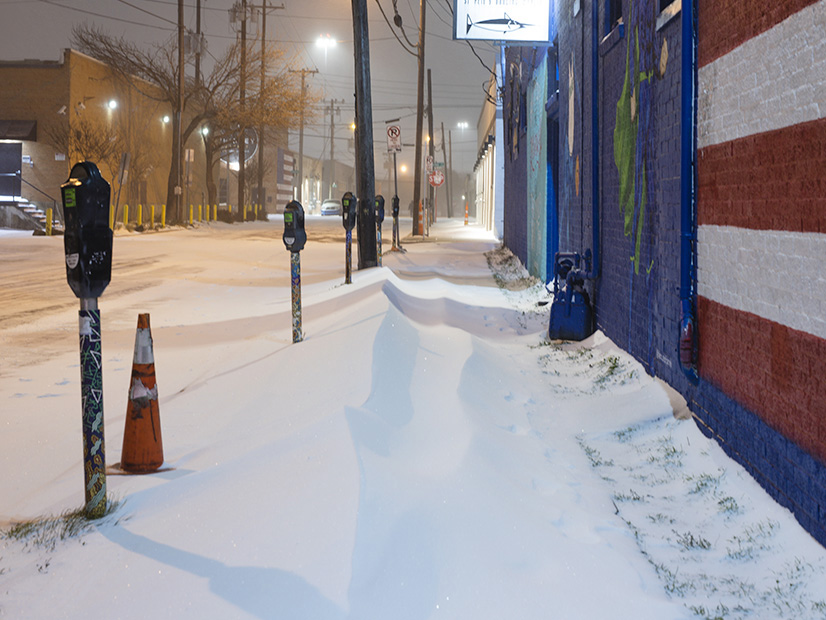
Members of the team working on NERC’s new cold weather standards project warned industry Tuesday that much work remains to be done to prevent grid damage from future extreme winter events.
In a webinar aimed at winning over industry stakeholders during the project’s first formal comment and balloting period, which began last Thursday, the standards development team (SDT) for Project 2021-07 (Extreme cold weather grid operations, preparedness and coordination) went over the changes that voters will find in the new standards: EOP-011-3 — Emergency operations, and EOP-012-1 — Extreme cold weather preparedness and operations.
NERC started the project last year in response to its joint inquiry with FERC into last February’s winter storms that knocked thousands of megawatts of capacity offline in Texas and left households across the state without power for days. (See FERC, NERC Release Final Texas Storm Report.) The goal of the standards project is to implement the report’s recommendations, which include requiring generator owners and operators to identify and protect cold weather-critical components, build or retrofit generating units to operate to specific ambient temperatures and weather, and perform annual training on winterization plans.
In a sign of the urgency with which FERC and the ERO Enterprise view the project, NERC’s Standards Committee voted last week to shorten the initial comment and ballot period from 45 days to 30, with voting to take place in the last 10 days. (See NERC Cold Weather Standards Set for Shortened Comment Period.)
Evergy’s Kenneth Luebbert, a member of the SDT, opened the webinar by reminding listeners that the industry already has many “tried and true methods” to prevent issues with winter weather, which the team expected would be part of their response to the standards; he also acknowledged that this may not be as easy in the case of newer technology.
“I don’t believe we [currently] have an industry-proven method to address icing on wind turbine blades,” Luebbert said, referring to one of the common causes of outages during last year’s storms. “So, when we go into the new standards … you’ll see that we have exceptions for where there [are] not commercially [or] technically available methods … and we have a way to address that. But where there is … our full expectation is that the industry would do those steps.”
Most of the new requirements developed by the SDT apply to EOP-012-1, the first planned standard to specifically address performance during cold weather. It includes minimum criteria for freeze protection measurements to be implemented by generator owners; for instance, generating units must be capable of continuous operation in the minimum hourly temperature experienced at their location since 1975 (or the earliest date for which reliable records are available). GOs are also expected to account for the effects of wind and precipitation.
For EOP-011-3, the SDT elected to expand requirement R1 to add additional criteria that transmission operators should consider when developing load-shedding procedures, and to revise R2 to clarify that TOPs are responsible for implementing the load-shedding provisions that balancing authorities create. The team also moved to EOP-012-1 several requirements that were added to EOP-011-2 as part of NERC’s last cold weather standards project, which FERC approved last year. (See FERC Approves Cold Weather Standards.)
Phase 2 Planned for Next Year
Team members also previewed future planned efforts to prepare the grid for extreme cold. The two standards discussed on Tuesday comprise Phase 1 of the overall cold weather strategy and are being developed under an accelerated schedule in hopes of submitting them to NERC’s Board of Trustees for approval by Sept. 30.
Phase 2 will address more recommendations from the FERC-NERC report, with the goal of sending more new standards to the board by Sept. 30, 2023. Issues to be tackled in this stage include specifying the role of GOs and GOPs, as well as BAs, in determining generator capacity, along with requirements protecting natural gas infrastructure from load shedding. Luebbert acknowledged that NERC had received requests to add these elements to the first phase but said the ERO decided to save them for next year so as not to overload the current project.
“To the extent Phase 1 was pretty meaty, and there was quite a bit we had to get done this year, we chose to go ahead and leave the phases as they were, and go ahead and address those requirements [in the] next phase,” Luebbert said. “So, to the extent industry would like to see more language around communication, that will be forthcoming.”



